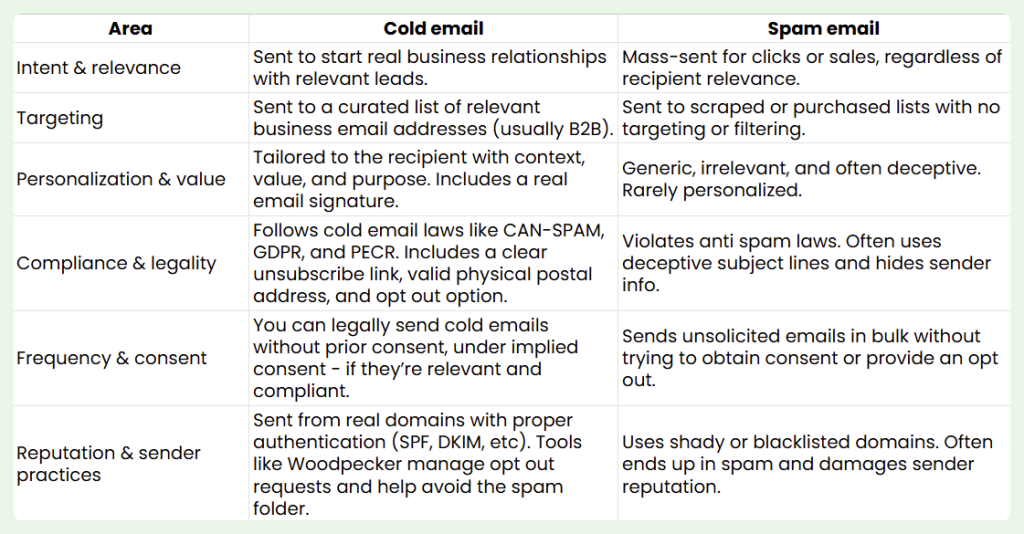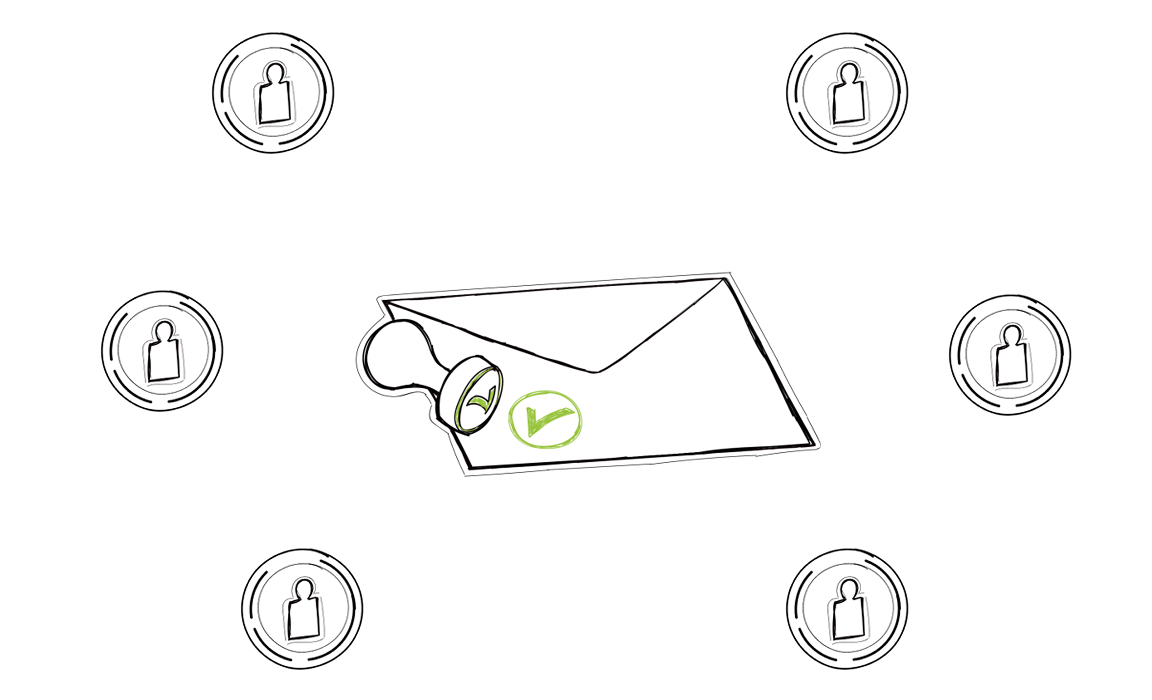Cold email outreach can be a powerful way to start business conversations – if you do it right.
But in 2025, with evolving data regulations and inbox filters getting smarter, many sales teams and founders ask the same question: Is cold emailing still legal?
This guide breaks down the key regulations, what (not) to do, and how to send cold emails that stay compliant and get results.
Whether you’re running a small campaign or scaling outbound with a tool like Woodpecker, you’ll learn how to abide by the law (and the spam filter).
Is cold email illegal?
No, cold emailing is not illegal.
In most countries, it’s perfectly legal to send emails to someone you haven’t interacted with before if you’re contacting them for legitimate business reasons and you respect their privacy rights.
Here’s what makes a cold email legal:
✅ You’re contacting a business, not a private individual (especially important under EU and UK laws)
✅ You include a clear way to opt out or unsubscribe
✅ You identify yourself and your business honestly (no fake names, spoofed domains, or misleading subject lines)
✅ You’re offering something relevant and non-deceptive (not phishing or selling shady products)
✅ You process and store contact data in line with data privacy laws (like GDPR or CAN-SPAM)
Cold email isn’t a loophole but a legitimate outreach channel when used responsibly.
Cold email vs spam: key differences
Cold email often gets lumped in with spam, but they’re not the same thing.
Legally and practically, the difference comes down to intent, relevance, and how you send the message.
Here’s how cold email stands apart from spam emails:

Is cold email legal in the United States?
Yes, cold email is legal in the U.S. if it complies with the CAN-SPAM Act – a federal law that sets the rules for commercial electronic messages.
You don’t need to obtain explicit consent to send a cold email in the U.S., but you do need to follow these basic rules:
How to stay compliant with the CAN-SPAM Act:
- ✅ Use accurate “From,” “Reply-To,” and domain names (no impersonation)
- ✅ Don’t use deceptive subject lines
- ✅ Clearly identify the message as a commercial email
- ✅ Include a visible and functional unsubscribe link or opt out option
- ✅ Honor opt out requests promptly (within 10 business days)
- ✅ Include your valid physical address or business address in every email
If your cold email campaigns meet these requirements, you’re legally allowed to continue sending unsolicited commercial messages to business contacts in the U.S.
Is cold email outreach legal in the European Union?
It’s more restricted but still legal to send cold emails under certain conditions.
In the EU, cold emailing is governed by the GDPR (General Data Protection Regulation) and the ePrivacy Directive, both of which are core parts of the region’s electronic communications regulations.
The key difference? Consent.
In most EU countries, you must either:
- ✅ Obtain explicit consent before sending a commercial email, or
- ✅ Prove a legitimate interest when emailing someone at their business address, and show that the email is relevant to their job
You also must:
- ✅ Clearly identify who you are and how you got their info
- ✅ Include an easy opt out mechanism
- ✅ Add a valid physical postal address
- ✅ Avoid sending irrelevant or mass outreach that feels like spam
To stay compliant, focus your cold email campaigns on relevant B2B contacts and make sure your messages are well-targeted and non-intrusive.
If you’re reaching out across borders, tools like Woodpecker help automate the compliance steps, so you don’t miss a required unsubscribe link or overlook an opt out request.
Cold email regulations in different parts of the world
Cold email laws vary depending on where your recipients are based.
While it’s generally legal to send commercial electronic messages, each country has its own rules around consent, opt-outs, and what qualifies as direct marketing communications.
Here’s a snapshot of how cold email campaigns are regulated in other major regions:

Before sending cold emails internationally, check if you need express consent or if implied consent (e.g., B2B relevance) is enough. Even in countries where cold outreach is legal, make sure your emails include:
- Honest sender details (no false information)
- A clear way to unsubscribe and honor unsubscribe requests
- Your full contact details and business address
- Security practices for storing data (appropriate data security)
Woodpecker helps you personalize your outreach to local laws, automatically handling unsubscribe requests and keeping your campaigns compliant across borders.
How to stay legal with cold emails – cold emailing rules
Staying compliant with cold email laws doesn’t mean overcomplicating your outreach.
Here’s how to keep it legal and ethical:
#1 Only email relevant prospects
Cold outreach must be targeted. In most countries, you’re allowed to send commercial electronic messages to B2B contacts if there’s a legitimate connection between their job role and your offer. Don’t email just to hit a volume quota; email to solve a problem instead.
Tip: With Woodpecker’s B2B lead database, you can find decision-makers who are actually a fit.
#2 Clearly identify yourself as a sender
Every cold email should include your full contact details, including your valid physical address or business address, and a real name or company identity. Avoid aliases and unbranded domains.
In short, don’t be like Amy S:
#3 Give an easy way to opt out of future emails
Whether it’s an unsubscribe link, a one-click opt out option, or clear instructions to stop contact, you must let people say no. And once they do, don’t email them again.
Good to know: Woodpecker automatically tracks unsubscribe requests and removes opted-out contacts from future sends.
#4 Avoid misleading subject lines and headers
This is a legal requirement under most anti spam laws. Be direct. Don’t try to “trick the open” with vague or deceptive subject lines e.g., by adding “re” to the subject line and trying to make it look a like a reply instead of a cold email. They hurt both your reputation and your inbox placement.
#5 Keep emails simple and honest (focus on the offer)
Skip the fluff. Your message should communicate a genuine business offer in plain language. Make it short and relevant. Think direct marketing communications, not persuasion games.
#6 Comply with regional laws
Know where your recipient is based. Some countries (like the U.S.) allow sending unsolicited commercial messages with disclosures, while others (like Canada) require express consent. If you’re emailing across borders, follow the electronic communications regulations that apply.
Woodpecker helps here too. Its campaign builder supports GDPR compliance and helps segment campaigns by region.
#7 Monitor deliverability and spam complaints
You can be fully compliant and still land in the spam folder if your sender reputation drops. Monitor open rates, bounces, and even domain health regularly.
Woodpecker includes tools like Deliverability Monitor, email warm-up, and adaptive sending to protect your domain and improve inbox placement.
#8 Respect frequency limits
Don’t overwhelm your prospects. If they haven’t replied after a few well-timed follow-ups, back off. Bombarding inboxes doesn’t just annoy people but can also flag your domain as spammy.
Send cold emails legally and confidently
The takeaway? It’s legal to send cold emails in most countries, as long as you’re “triple R”: relevant, respectful, and reasonable. That means:
- Reaching out to the right people for the right reasons
- Providing a clear opt out
- Following regional electronic communications regulations
- Never disguising your intent or identity
Plus, with a tool like Woodpecker, you can automate the tricky parts without cutting corners.
👉 Start your free trial and set up your first compliant cold email campaign in minutes. No credit card needed. All features unlocked.

